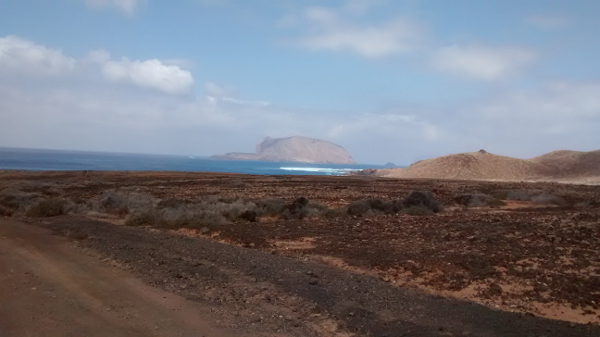We arrived at the airport with plenty of time to spare before the flight. As the flight time got nearer they said that the flight was delayed, it ended up being delayed by 1.5 hours, not a great start to the holiday. When we eventually landed in Lanzarote we picked up the car and made the trip to the Casa Tomaren without any problems.
Although it was dark when we arrived at the hotel it looked very grand and we were met by one of the staff who showed us to our room, which looked very old and quaint. As it was late when we arrived we drove to a nearby 24-hour shop at a petrol station to get a snack before retiring for the night.
 |
| Casa Tomaren pool |
 |
| Part of the Casa Tomaren gardens |
Casa Tomaren was in a beautiful quiet location in the middle of the island, with only a 20-minute drive to anywhere on the island. Very helpful staff who were able to tell you all you wanted to know about everywhere. Nicely decorated throughout both inside and outside and a great breakfast buffet. We would definitely stay there again as you can explore the whole island in a week.
Los Hervideros is a series of pathways, designed by Cesar Manrique, on the cliffs above the sea and when the waves are big the water forces it's way into underwater caves and blowholes, very similar to Pancake Rocks in New Zealand's south island.
From there we drove to El Golfe which is a quaint little village where there is another cliff walk with amazing views of the ocean and beaches and one of the beaches has a green lagoon caused by the algae which live there.
The final destination of the day was a visit to Salinas de Janubio which are salt flats and the piles of white salt look strange in this environment which consists mostly of black lava
 |
| Salt flats |
That evening we decided to try the Teleclub de Tao for a meal. It was great value for money. It is a social club for the village but don't let that put you off as the food was really good.
Busy day ahead sightseeing went to Casa Museo Monumento al Campesino first. As it says in the name it is a house, museum, and monument. The 15-metre monument was built in 1968 to represent Fertility and was made of old water tanks.
 |
| Bit late my dear |
It was designed by Cesar Manrique and built by Jesus Soto, Cesar's designs are featured all over the island. The house (museum) is a reconstruction of a typical Canarian farmhouse. Below ground is a fine restaurant which would make an ideal location for weddings, unfortunately, it is not open in the evenings so we did not eat there. The buildings are surrounded by agricultural land including a typical Canarian vineyard.
Next up was the Cesar Manrique Foundation which is located in Taro de Tahiche and was the home and studio of the artist and was built in 1968 on top of 5 volcanic bubbles left by the eruptions on the island during 1730-36. These bubbles form part of the living space. The foundation is a non-profit organization where the money is used for conservation and art projects on the island.
After this, we went to the Jameos del agua, another of Cesar's projects, which is a grotto containing an underground auditorium used for musical concerts.
Today we visited the Cueva de los Verdes which are caves going through lava tubes about 2 kilometers were developed for tourists in the 1960's and is also used as a concert hall with seating for around 500 people.
Just up the road from here we visited the Mirador del Rio, another Cesar Manrique project created in 1974, with marvelous views down sheer cliffs to the sea below and across the strait of Rio to the island of La Graciosa.
During the later part of Cesar Manrique's life, he moved from Tahiche to Haria and this house is where he lived until his tragic death in a road accident in 1992, the house still contains his clothes and slippers beside his bed. It is another beautifully designed house where you are only allowed to take photos outside.
That night we went for a meal at La Cantina in Teguise which was very good.
 |
| Before the meal |
 |
| After the meal |
Today we went to LagOmar museum which was a beautiful house built into the rocky cliffs which was conceived by Cesar Manrique and designed by artist Jesus Soto. At one time the house was owned by Omar Sharif who unfortunately lost it in a card game, hence the name LagOmar, today it is a museum and restaurant and open to the public.
After this, we took the ferry across to La Graciosa island where we had a nice walk around for a couple of hours, not much else to do unless you were camping there for the night.
Had a walking day today so we drove to El Golfe and walked along the coastal path amongst the lava fields for a couple of hours. We then went inland and walked along a track through the vines.
 |
| More vines |
Our last day in Lanzarote we went to Caleta de Famana which is a small village with a beautiful beach which was full of surfers,
then we drove to have a look around the main town on the island, Arracife, which was very busy not at all what we had been used to all week.
The flight home was delayed so we did not arrive back until 2am, but had a nice holiday anyway.
Labels: spain





























































